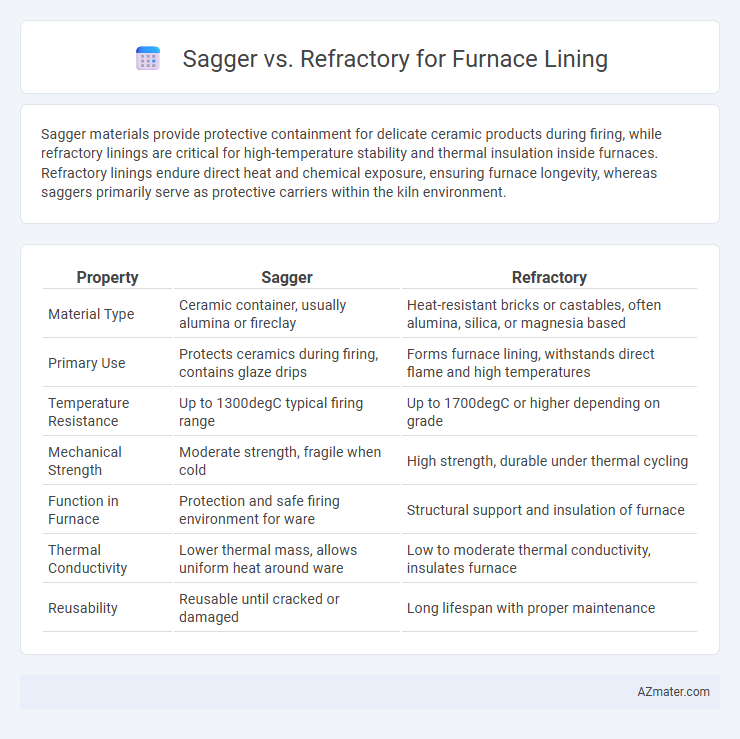Sagger materials provide protective containment for delicate ceramic products during firing, while refractory linings are critical for high-temperature stability and thermal insulation inside furnaces. Refractory linings endure direct heat and chemical exposure, ensuring furnace longevity, whereas saggers primarily serve as protective carriers within the kiln environment.
Table of Comparison
| Property | Sagger | Refractory |
|---|---|---|
| Material Type | Ceramic container, usually alumina or fireclay | Heat-resistant bricks or castables, often alumina, silica, or magnesia based |
| Primary Use | Protects ceramics during firing, contains glaze drips | Forms furnace lining, withstands direct flame and high temperatures |
| Temperature Resistance | Up to 1300degC typical firing range | Up to 1700degC or higher depending on grade |
| Mechanical Strength | Moderate strength, fragile when cold | High strength, durable under thermal cycling |
| Function in Furnace | Protection and safe firing environment for ware | Structural support and insulation of furnace |
| Thermal Conductivity | Lower thermal mass, allows uniform heat around ware | Low to moderate thermal conductivity, insulates furnace |
| Reusability | Reusable until cracked or damaged | Long lifespan with proper maintenance |
Introduction to Furnace Lining Materials
Sagger and refractory materials serve distinct roles in furnace lining, with saggers primarily used as protective containers for delicate materials during high-temperature processes, while refractories form the essential heat-resistant lining that maintains structural integrity and thermal insulation. Refractory linings, composed of ceramics or fireclays, withstand extreme temperatures, chemical corrosion, and mechanical wear, ensuring efficient furnace operation. Selecting the appropriate combination of sagger and refractory materials is critical to optimizing furnace performance and prolonging equipment lifespan.
What is a Sagger?
A sagger is a protective ceramic container used in furnace linings to shield delicate materials or objects from direct flame and contamination during high-temperature processes. Made from refractory materials like clay, alumina, or silica, saggars provide thermal insulation and chemical stability inside industrial kilns or furnaces. Their role is critical in preventing damage and ensuring uniform heat distribution while maintaining the integrity of the items being fired or processed.
Understanding Refractory Materials
Refractory materials for furnace lining, such as sagger and traditional refractories, both provide heat resistance but differ in application and composition. Sagger, primarily used as a protective container for ceramics during firing, offers precise thermal insulation but lacks the structural robustness of bonded refractories, which are engineered to withstand high mechanical stress and thermal shock. Understanding the mineral composition and thermal conductivity of refractory materials is essential to optimize furnace efficiency and prolong lining lifespan in industrial settings.
Key Differences Between Sagger and Refractory
Sagger is a protective container made from refractory materials used to enclose and shield products during high-temperature firing processes, preventing direct contact with flames and contaminants. Refractory refers to the heat-resistant materials that form the furnace lining, providing thermal insulation, structural support, and resistance to chemical corrosion and thermal shock. The key difference lies in their function: sagger acts as a protective vessel for items inside the furnace, while refractory constitutes the furnace's heat-resistant structural layer that maintains operational integrity.
Performance Comparison: Sagger vs Refractory
Saggers provide superior protection for delicate materials during high-temperature processes by creating a controlled microenvironment, preventing contamination and oxidation. Refractory linings excel in structural durability and thermal insulation, maintaining furnace stability under extreme heat and mechanical stress. The choice between saggers and refractory depends on prioritizing precise atmosphere control versus overall furnace structural integrity and heat retention.
Durability and Lifespan Considerations
Sagger materials offer moderate durability for furnace lining but typically have shorter lifespans compared to refractory linings, which are engineered with high-density ceramics capable of withstanding extreme temperatures and thermal shock. Refractories provide superior resistance to corrosion, abrasion, and chemical attack, directly enhancing operational longevity and reducing maintenance frequency. Selecting refractory lining over saggers results in greater furnace efficiency and cost-effectiveness due to extended service intervals and reduced downtime.
Cost Analysis: Sagger vs Refractory
Sagger and refractory materials both serve essential roles in furnace lining but differ significantly in cost-effectiveness. Saggers, typically made from high-temperature ceramics, offer lower initial costs and ease of replacement compared to traditional refractory bricks, which have higher durability but come with higher material and installation expenses. Evaluating total cost of ownership, including maintenance frequency and lifespan, reveals that while refractory linings incur greater upfront investment, their longer service life can lead to reduced long-term operational costs relative to saggers.
Application Suitability in Industrial Furnaces
Sagger linings are ideal for protecting delicate products from direct flame exposure and contamination during high-temperature firing processes, especially in ceramic and glass industries. Refractory linings provide superior thermal insulation and structural strength, making them suitable for high-temperature industrial furnaces handling molten metals, steel, and cement production. The choice between sagger and refractory linings depends on temperature resistance requirements, product protection needs, and the furnace's operational environment.
Thermal Efficiency and Energy Consumption
Sagger materials in furnace lining offer superior thermal insulation properties that minimize heat loss, enhancing overall thermal efficiency compared to traditional refractory linings. The dense and heat-retentive structure of saggers reduces energy consumption by maintaining higher internal temperatures with less fuel input. Refractory linings, while durable, often allow more heat dissipation, leading to increased fuel usage and lower thermal efficiency in industrial furnace applications.
Choosing the Right Furnace Lining: Factors to Consider
Choosing the right furnace lining involves evaluating the thermal resistance, chemical stability, and mechanical strength of saggers versus refractory materials to ensure optimal performance and durability. Saggers excel in protecting against contamination and thermal shock in high-temperature processes, while refractories offer superior insulation and structural integrity for prolonged furnace operations. Consider the operating temperature, furnace atmosphere, and maintenance requirements to select the lining that maximizes energy efficiency and equipment lifespan.

Infographic: Sagger vs Refractory for Furnace lining
 azmater.com
azmater.com